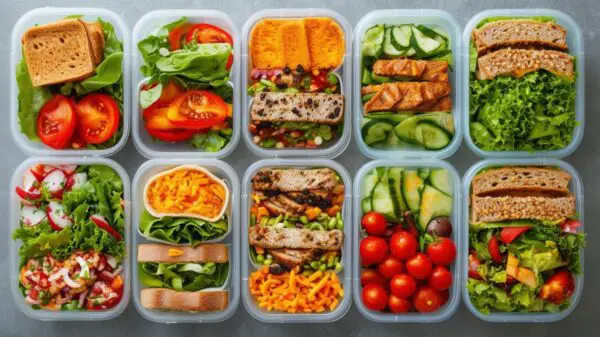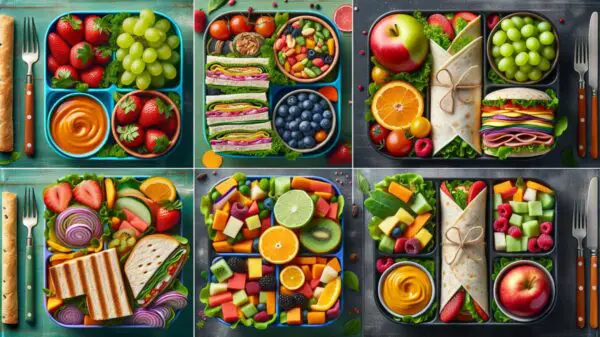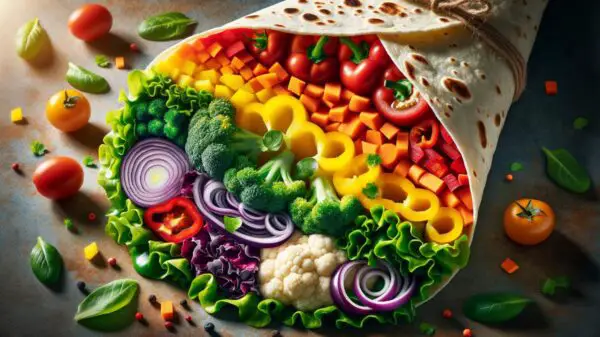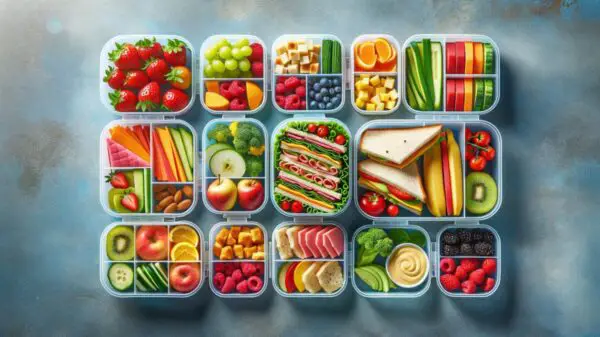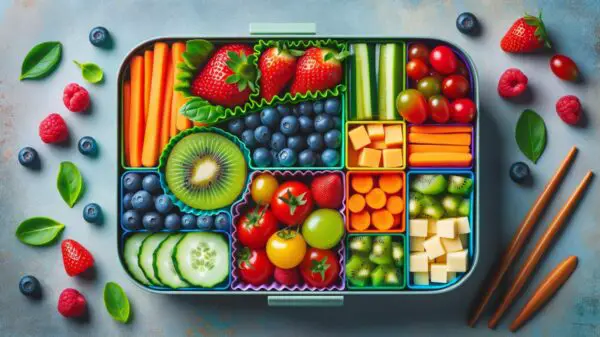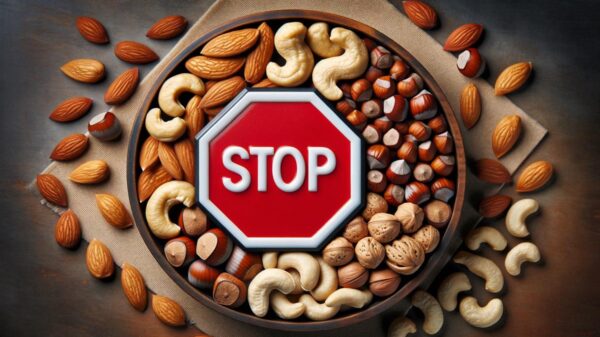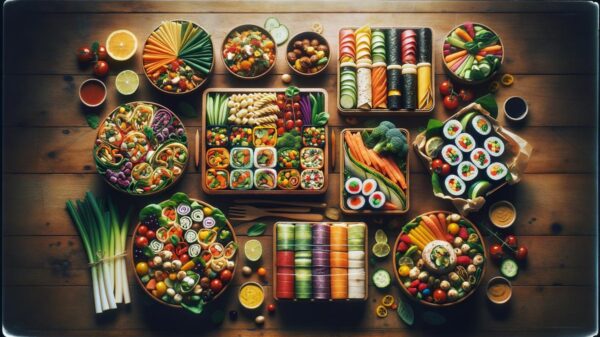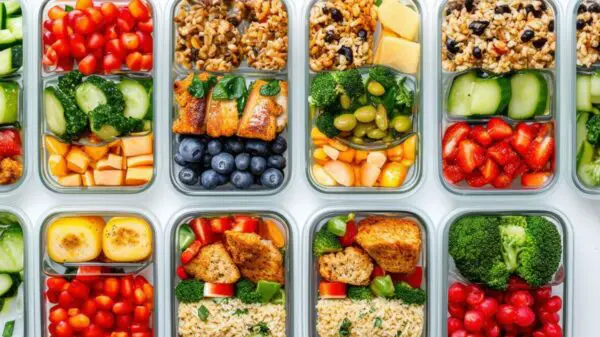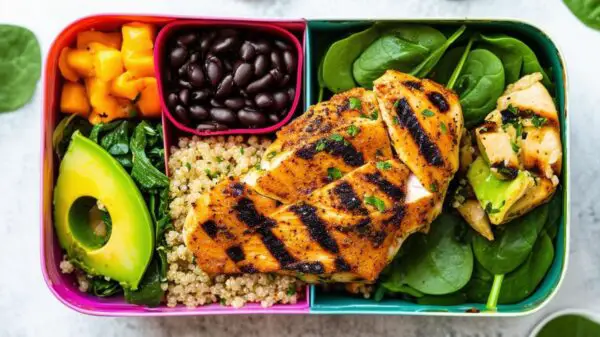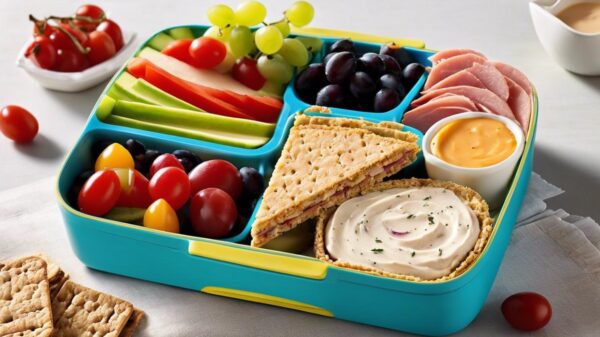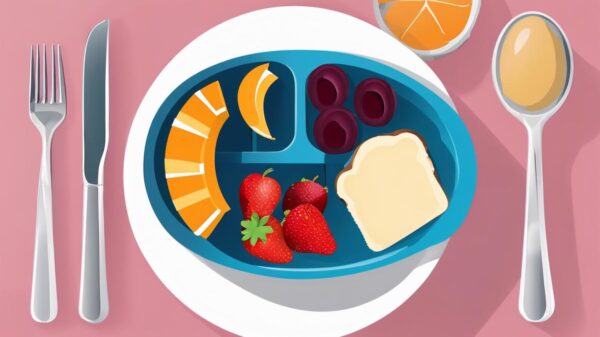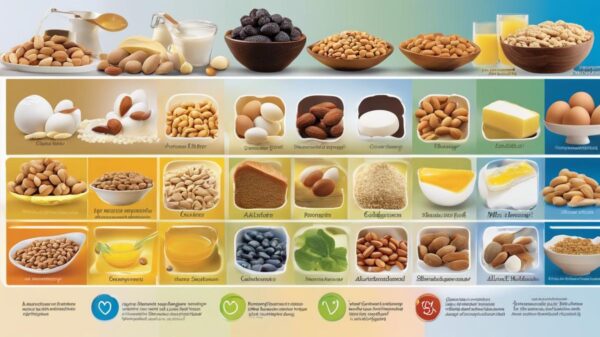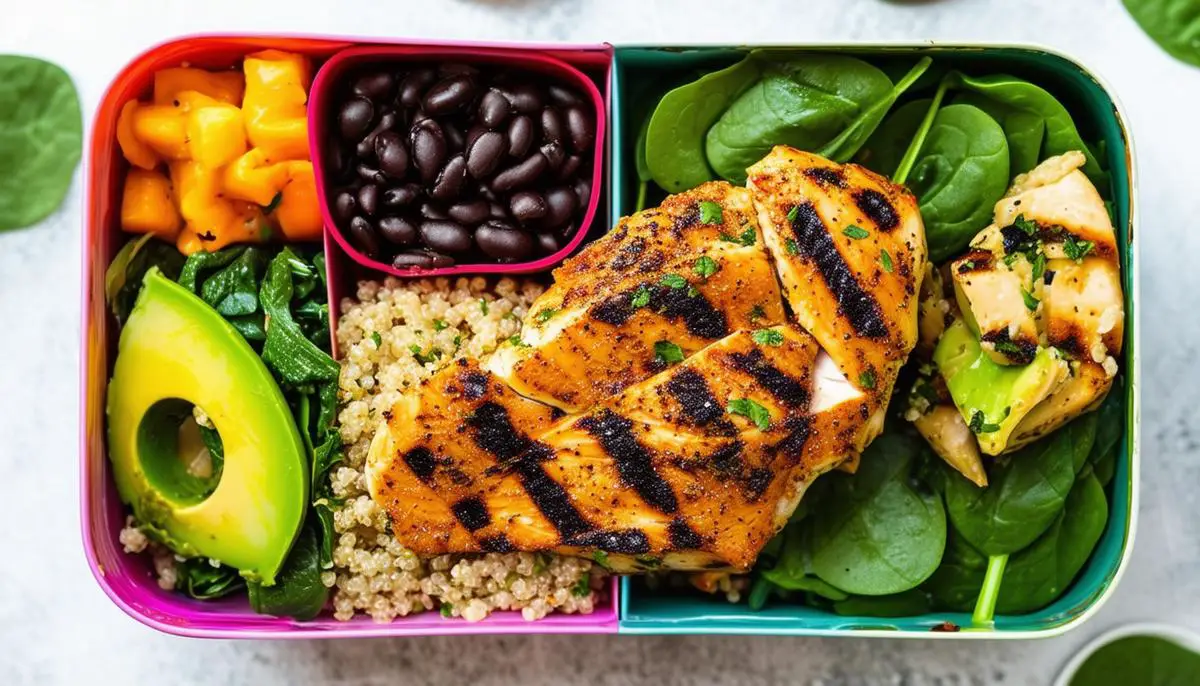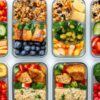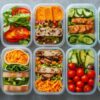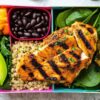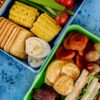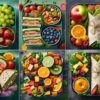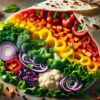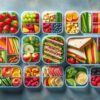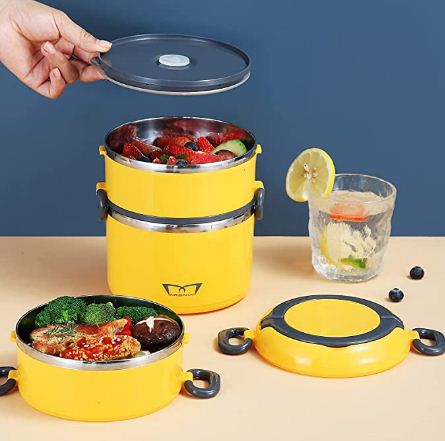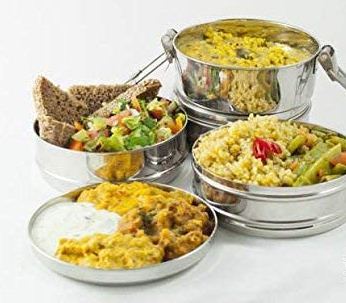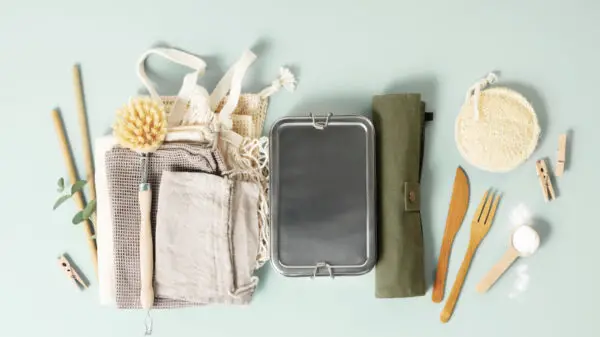Boosting Your Lunch with Energy Foods
Foods like sweet potatoes or quinoa not only satisfy hunger but also offer a slow release of energy, preventing afternoon slumps. Complex carbs maintain blood sugar levels, crucial for sustained cognitive function and alertness.
Proteins extend that heightened state of wakefulness into your afternoon schedule. A turkey or chicken wrap with slices of avocado contains lean protein and healthy fats, aiding your metabolic dynamism.
Peanut butter on whole-grain bread is another excellent example – engaging palates while providing lean protein, healthy fats, and stable blood sugar progression.
Leafy greens, such as spinach, bear immense folates essential for energy generation at a cellular level, spiking enthusiasm and field performance concurrently.
Pairing these elements astutely throughout your lunch impacts your afternoon alertness, overall health trajectory, and work performance spectrum. Make your midday meal count – let it be a pivotal appliance in your energy management system to conquer daily endeavors with relentless vigor.
Key Nutrients for Sustained Energy
B vitamins, iron, and omega-3 fatty acids play pivotal roles in maintaining steady energy levels throughout the day.
B vitamins, including B12, B6, and folate, are crucial for converting dietary energy into ATP (adenosine triphosphate), the form of energy your body uses. Rich sources include whole grains, meat, eggs, and dairy products, which seamlessly integrate into lunchtime meals like salads and sandwiches.
Iron is fundamental in the production of hemoglobin, which transports oxygen in the blood. Optimal oxygen circulation is essential for maintaining energy and focus. Iron-rich foods such as lean meats, beans, and fortified cereals can be key components of a power-packed midday meal.
Omega-3 fatty acids assist in regulating blood sugar levels, helping to stabilize energy. Incorporate foods like salmon, chia seeds, and walnuts into your lunches to harness these benefits.
Understanding the synergy of these nutrients and including them in your diet ensures sustained energy, aiding in more productive and alert afternoons.
Recipe Ideas for Energy-Boosting Lunches
- Mediterranean Chickpea Salad Bowl
Combine chickpeas, diced cucumbers, halved cherry tomatoes, sliced red onion, and crumbled feta cheese. Dress with olive oil, lemon juice, salt, and pepper. Serve over spinach for an iron-rich, nutritious lunch balancing proteins, fats, and carbs. - Turmeric Tuna and Avocado Wrap
Mix canned tuna with low-fat yogurt, turmeric, and black pepper. Spread onto a whole-grain wrap, add avocado slices and mixed greens. Roll tightly for a lunch rich in omega-3 fatty acids, protein, and essential fibers. - Quinoa and Roasted Vegetable Salad
Toss cooked quinoa with roasted bell peppers, zucchini, and red onion. Add chopped walnuts and dress with balsamic vinaigrette. This dish combines complex carbs, protein, and healthy fats, ideal for energy sustenance. - Chicken and Hummus Pita Pocket
Stuff a whole-grain pita with grilled chicken strips, homemade hummus, sliced cucumbers, and tomatoes for a good mix of protein, fats, and slow-digesting carbs. - Beef and Broccoli Stir-Fry
Sauté thin strips of lean beef and broccoli florets in olive oil, garlic, and soy sauce. Serve over brown rice for a fulfilling meal providing protein, fiber-rich carbs, and essential vitamins. - Salmon Salad with Mixed Greens
Flake cooked salmon over mixed greens. Add avocado slices and sesame seeds. Dress with olive oil and lemon juice. Excellent for a dose of omega-3 fatty acids and protein. - Sweet Potato and Black Bean Burrito
Fill a whole-grain tortilla with mashed sweet potatoes, cooked black beans, Greek yogurt, and chopped cilantro. Packed with fiber and protein for long-lasting energy. - Lentil Soup with Spinach
Simmer cooked lentils, diced tomatoes, spinach, and carrots in vegetable broth seasoned with cumin and coriander. A comforting soup ensuring a steady supply of iron, protein, and fiber.
These recipes focus on integrating macro-nutrients essential for sustaining high energy levels throughout the day and simplify meal preparation for work environments. They are easy to make ahead and carry, making them optimal for busy professionals.
Grilled Chicken and Quinoa Salad
Ingredients:
- 1 cup quinoa
- 2 cups water
- 2 chicken breasts, boneless and skinless
- 1 tablespoon olive oil
- Salt and pepper, to taste
- 1 cup cherry tomatoes, halved
- 1 avocado, diced
- 1/2 red onion, thinly sliced
- 1/4 cup fresh parsley, chopped
- Juice of 1 lemon
- 2 tablespoons extra-virgin olive oil
- 1 garlic clove, minced
Instructions:
- Rinse the quinoa under cold water until the water runs clear. In a medium saucepan, combine the rinsed quinoa and 2 cups of water. Bring to a boil, then reduce heat to low, cover, and simmer for about 15-20 minutes until the water is absorbed and the quinoa is tender. Remove from heat and let it stand for 5 minutes, then fluff with a fork.
- While the quinoa is cooking, prepare the chicken. Heat 1 tablespoon of olive oil in a grill pan over medium-high heat. Season the chicken breasts with salt and pepper, and place them in the pan. Grill for about 6-7 minutes on each side, or until the chicken is thoroughly cooked and has nice grill marks. Remove from the pan and let it rest for a few minutes before slicing.
- In a large bowl, combine the cooked quinoa, sliced grilled chicken, cherry tomatoes, diced avocado, red onion, and parsley.
- In a small bowl, whisk together the lemon juice, extra-virgin olive oil, minced garlic, salt, and pepper to create a dressing.
- Pour the dressing over the salad and gently toss to combine all the ingredients.
- Serve immediately or chill in the refrigerator before serving.
Nutritional information per serving:
- Calories: 480 kcal
- Carbohydrates: 42 g
- Protein: 36 g
- Fat: 21 g
- Fiber: 9 g
- Sugar: 5 g
- Sodium: 280 mg
This Grilled Chicken and Quinoa Salad is rich in protein and packed with healthy fats and fiber, all key components for an energy-sustaining meal. The quinoa provides complete protein and fiber, aiding in slow energy release. Avocado offers healthy monounsaturated fats, promoting satiety and steady blood sugar levels. The fresh lemon in the dressing brings vitamin C, enhancing iron absorption from the quinoa and chicken, making it an excellent dish for maintaining high energy levels throughout the afternoon.
Avocado and Black Bean Wrap
Ingredients:
- 2 whole-grain tortillas
- 1 ripe avocado
- 1 cup canned black beans, rinsed and drained
- 1/2 red bell pepper, diced
- 1/2 small red onion, thinly sliced
- 1/4 cup fresh cilantro, chopped
- Juice of 1 lime
- Salt and pepper, to taste
- 1/2 teaspoon ground cumin
- 1/4 teaspoon chili powder
- 1/2 cup shredded lettuce or mixed greens
- Optional: 1/4 cup crumbled feta cheese or shredded cheddar cheese
Steps:
- Prep your ingredients: slice the avocado in half, remove the pit, and scoop the flesh into a bowl. Mash the avocado with a fork until it reaches your desired consistency. Add the lime juice, salt, pepper, cumin, and chili powder to the mashed avocado and stir to combine.
- Add the black beans, diced red bell pepper, sliced red onion, and chopped cilantro to the avocado mixture. If using cheese, add it now. Mix gently until all the ingredients are well combined.
- Lay out the whole-grain tortillas on a flat surface. Distribute the shredded lettuce or mixed greens evenly across the tortillas.
- Spoon half of the avocado and black bean mixture down the center of each tortilla. Be mindful not to overfill to ensure easy wrapping.
- Fold the bottom of each tortilla up over the filling, then fold both sides inwards to enclose the filling completely. Roll the tortilla from the bottom to secure everything inside. If necessary, use a toothpick to keep each wrap intact.
- Serve immediately or wrap in parchment paper for a convenient on-the-go lunch.
Nutritional information (per serving):
- Calories: 380 kcal
- Carbohydrates: 48 g
- Protein: 14 g
- Fat: 16 g
- Fiber: 15 g
- Sodium: 480 mg
This wrap is packed with fiber from both the black beans and whole grains, and offers heart-healthy fats from its avocado content. The mixture provides a balanced array of nutrients, making it a satisfying and invigorating lunch choice to sustain high energy levels throughout the day. Its ease of preparation also makes it an ideal option for an energizing meal.
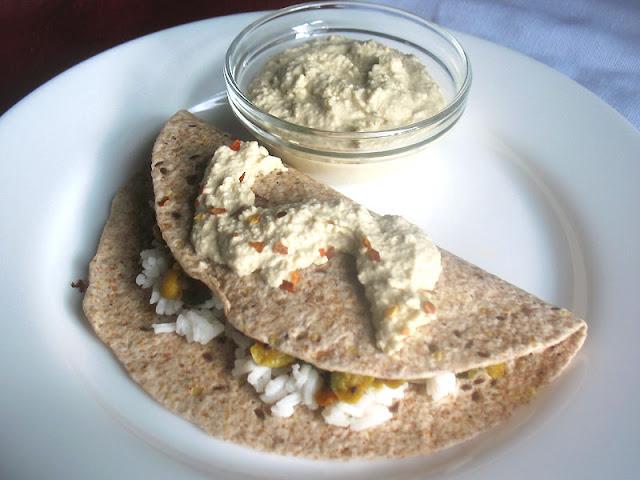
Spinach and Salmon Protein Bowl
Ingredients:
- 1 salmon fillet (about 6 oz)
- 2 cups fresh spinach leaves
- 1/2 cup cooked quinoa
- 1 tablespoon olive oil
- 1/2 lemon, juice and zest
- 1 small avocado, sliced
- 1/4 cup cherry tomatoes, halved
- 1/4 red onion, thinly sliced
- Salt and pepper to taste
- 2 tablespoons balsamic vinegar
Preparation Steps:
- Preheat the oven to 375°F (190°C). Place the salmon fillet on a baking sheet lined with parchment paper. Drizzle with half the olive oil and season with salt and pepper. Bake for about 15-20 minutes, or until the salmon is cooked through and flakes easily with a fork.
- While the salmon is cooking, prepare the quinoa according to package instructions if not already cooked.
- In a large mixing bowl, add the spinach leaves. Squeeze lemon juice over the spinach, and add the remaining olive oil and balsamic vinegar. Toss the leaves to coat them evenly.
- Add the cooked quinoa to the spinach and mix well.
- Once the salmon is cooked, let it cool for a few minutes then flake the salmon using a fork.
- Add the flaked salmon, sliced avocado, cherry tomatoes, and red onion to the bowl with the spinach and quinoa. Gently toss everything together.
- Serve the protein bowl immediately, garnished with lemon zest for a fresh, citrusy accent.
Nutritional information (per serving):
- Calories: 520 kcal
- Carbohydrates: 28 g
- Protein: 36 g
- Fat: 30 g
- Fiber: 10 g
- Sodium: 150 mg
This recipe creates a balanced lunch option that sustains high energy levels. Salmon is an excellent source of omega-3 fatty acids and protein, essential for brain function and sustained energy. Spinach provides an abundance of vitamins like folate which assists in energy generation at the cellular level1. Quinoa serves as a healthy gluten-free source of carbohydrates that are rich in fiber, aiding in prolonged satiety and steady energy release. Avocado adds both texture and heart-healthy fats, while cherry tomatoes and red onion offer freshness and a boost of antioxidants.

